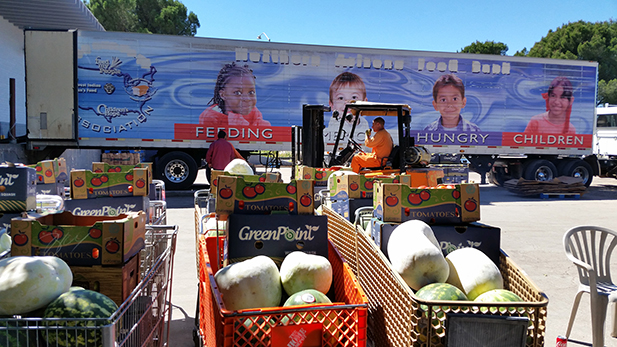 Borderlands Food Bank in Nogales, Arizona rescues Grade-A produce from the landfill and redistributes it throughout the country. At their warehouse, a $3 suggested donation gets you more than 60 pounds of food.
Borderlands Food Bank in Nogales, Arizona rescues Grade-A produce from the landfill and redistributes it throughout the country. At their warehouse, a $3 suggested donation gets you more than 60 pounds of food.Production of Feeding Our Future is made possible with the support of the Zuckerman Family Foundation.
At a quarter to six on a Saturday morning, people are lining up in the parking lot of an industrial park on Ina Road and Oldfather. This is POWWOW, Produce on Wheels Without Waste. It’s a pop-up market. An hour ago, a truck from Borderlands Food Bank drove up from Nogales (Arizona) and unloaded pallets of fruits and vegetables. Now volunteers are ripping into those boxes and spreading the food out on a long line of tables. They’re getting ready to hand it out to the crowd.
Ten dollars gets you around 60 pounds of produce. “They’re not really selling the produce; they’re basically asking for donations,” says Bob Darling. He’s a POWWOW volunteer with a group from his church. “They’re able to keep their equipment up, pay for their drivers and their fuel.”
The volunteer hands out a list of what’s being offered as the first in line starts to fill a box: 11 organic oranges, nine cucumbers, three honeydew melons, a fairy pumpkin, five pounds of grape tomatoes, 15 Roma tomatoes, 15 tomatoes on the vine and four pounds of chilies.
Where does all this food come from and why is it so inexpensive?
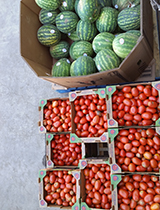 Billions of pounds of Grade-A produce get dumped in landfills on the border. Distributors let Borderlands take it and redistribute it.
Billions of pounds of Grade-A produce get dumped in landfills on the border. Distributors let Borderlands take it and redistribute it.“They get all the produce in from Mexico,” explains Darling. He’s slightly out of breath as he carries a shopper’s boxes to her car.
Billions of pounds of produce come across the border in Nogales every year. It’s the largest port of entry in the United States for produce. All that produce then waits in warehouses until it’s ordered and shipped out.
“And this is produce that they pretty much didn’t get shipped out or didn’t get ordered,” says Darling.
Produce distributors regularly get stuck with product that they can’t sell.
Maybe there was a glut on the market. Maybe the tomatoes on the vine are missing some stems, or the carrots are the wrong shape. Produce distributors regularly get stuck with product that they can’t sell, and they have to make room for next week’s delivery. Distributors have two options: take it to the landfill, or donate it to food redistributors like Borderlands Food Bank.
“This is one way of keeping it from going to waste,” says Bob Darling.
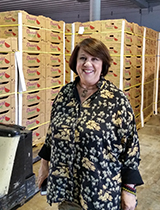 “I hate waste!” says Yolanda Soto, CEO of Borderlands Food Bank.
“I hate waste!” says Yolanda Soto, CEO of Borderlands Food Bank. Yolanda Soto hates waste. She’s President and CEO of Borderlands Food Bank. “We rescue fresh produce,” she says -- between 30 and 40 million pounds a year.
Borderlands is not your typical food bank. You don’t have to show ID to get food. There’s no macaroni or canned vegetables. It only distributes fresh produce.
Soto says she came up with the idea in 1995, to approach distributors and offer to take the edible food off their hands.
“It’s cost-effective for them because it costs them to dump,” she says. “It’s $40 a ton to go to the dump.” She says distributors who donate it to a nonprofit can get back some of the taxes they paid at the border to bring the food across.
“We only pick up 75% or better product. So in a box of tomatoes that has 10 tomatoes, 8 of them better be good,” says Soto. That produce doesn’t have much shelf-life left before it goes bad, so it has to be used quickly. Borderlands distributes it directly from their warehouse in Nogales. For a $3 suggested donation, individuals and organizations can load up their cars and pick-ups with boxes and boxes of fresh, Grade-A produce.
Borderlands is not your typical food bank. There’s no macaroni or canned vegetables. It only distributes fresh produce.
“Our 80% to 90% good product we save for Produce On Wheels,” she says. That’s POWWOW.
The produce that’s 90% to 100% edible Borderlands offers to food banks in 19 other states. Soto sends out a mass email. “And so they’ll start answering, ‘I want one; I want one; I want one.’ And they hire their transportation to come down here and pick it up. For instance I just sent out over 25 loads of watermelon all over the United States.”
Borderlands charges those food banks a penny a pound. It used to give the food away for free to other food banks, but in 2007, Borderlands lost a grant from the Arizona Department of Economic Security (DES). Those were its operational dollars. Borderlands lost its air-conditioned warehouse. The one it’s in now is a rental.
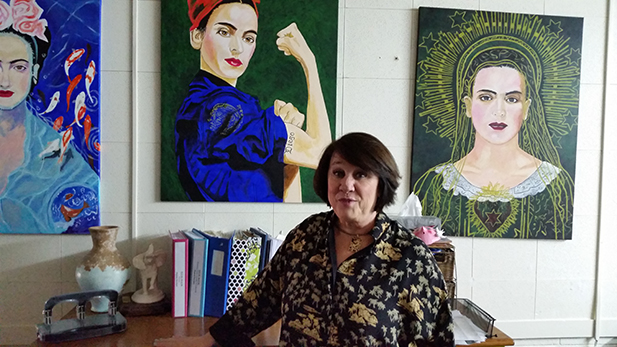 Yolanda Soto, CEO and President of Borderlands Food Bank, in her office in Nogales. The bright paintings on her walls were all done by an inmate who works for Borderlands as part of a labor force program. (She’s a big fan of Kahlo’s.)
Yolanda Soto, CEO and President of Borderlands Food Bank, in her office in Nogales. The bright paintings on her walls were all done by an inmate who works for Borderlands as part of a labor force program. (She’s a big fan of Kahlo’s.)The other thing you notice when you visit Borderlands are all the guys in orange jumpsuits.
“These warehouses are really old,” says Soto. “They were built in the ’50s. And at that time it wasn’t a requirement to have drains on the floor.” Some days, the floor are wet. There’s no refrigeration, so on a hot day it smells of rotting food. Flies are everywhere.
The other thing you notice when you visit Borderlands are all the guys in orange jumpsuits.
“We have 12 gentlemen from the Arizona Department of Corrections. They are the labor force behind what we do,” says Soto. “We could never do what we do without them. And they have great expertise: electrical, mechanical, construction. There are so many things they help us with that we just couldn’t afford. We do pay them a whole fifty cents an hour, if you can imagine that. It’s only about $11,000 in our budget.” That’s all she’s allowed to pay them, by law.
“My mission is to rescue as much as I can and get it to as many homes as possible, and I can’t do it without a bigger warehouse and an air-conditioned warehouse.” – Yolanda Soto, CEO, Borderlands Food Bank
Borderlands Food Bank has a small staff. “I only have the three drivers right now, and my Director of Operations and myself here in the warehouse.”
No development director. Most food banks run on grants and private philanthropy. Yoli Soto has a friend in the back room who’s trying to raise some money making phone calls to local businesses. She’s seeing if they want to buy ads on Borderlands’ trucks. Even if she sells ads on every truck it’s not going to be enough to get Borderlands the warehouse it needs.
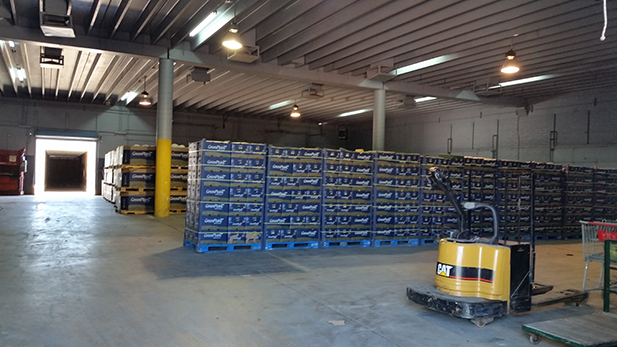 Borderlands rents a warehouse. It was built in the 1950s and doesn’t have drainage or air conditioning.
Borderlands rents a warehouse. It was built in the 1950s and doesn’t have drainage or air conditioning.“I’m waiting for the pie in the sky,” she says. “I’m waiting for that person that wants to partner with us. My mission is to rescue as much as I can and get it to as many homes as possible, and I can’t do it without a bigger warehouse and an air-conditioned warehouse.”
Across the street from Borderlands Food Bank there is a big warehouse, with refrigeration and air conditioning. It belongs to the Community Food Bank of Southern Arizona.
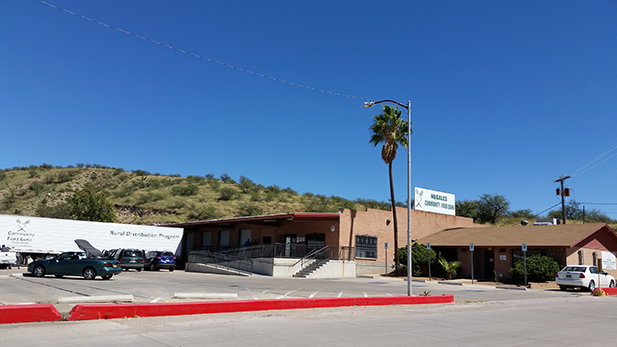 The Nogales Community Food Bank is expanding its produce rescue operations in partnership with St. Mary’s Food Bank in Phoenix.
The Nogales Community Food Bank is expanding its produce rescue operations in partnership with St. Mary’s Food Bank in Phoenix.Does the Nogales branch of the Community Food Bank collaborate with Borderlands Food Bank? It’s practically across the street.
Arthur Espinoza is CEO of the Nogales branch of the Community Food Bank. He also has another job title: Produce Solicitor.
“We sit in a very unique place as the entrance of Mexico and the U.S.,” says Espinoza. “Over 300 billion pounds of produce come through this port of entry and we have the fortune of being able to work with distributors and brokers to make sure that their product gets donated to the Food Bank. We don’t want them to go to the landfill.”
Does the Nogales branch of the Community Food Bank collaborate with Borderlands Food Bank? It’s practically across the street.
“Borderland Food Bank is not part of our network,” he says, and “I don’t really know what their programs are.”
“People start up food rescue programs that other people then look at and say, ‘Why are you getting that food and why are we not getting that food?’ ” – Michael McDonald, CEO, Community Food Bank of Southern Arizona
It was actually the Community Food Bank of Southern Arizona that underbid Borderlands for that big DES grant back in 2007. Soto says it hired an “ex disgruntled employee of mine.” It was Arthur Espinoza.
“I think it’s great that people in this community have the opportunity to go to two food banks,” says Espinoza.
“Food is very political,” says Michael McDonald. He became CEO of the Community Food Bank two years ago. “It was an eye-opener for me to realize that there are these tensions. People start up food rescue programs that other people then look at and say, ‘Why are you getting that food and why are we not getting that food?’ ”
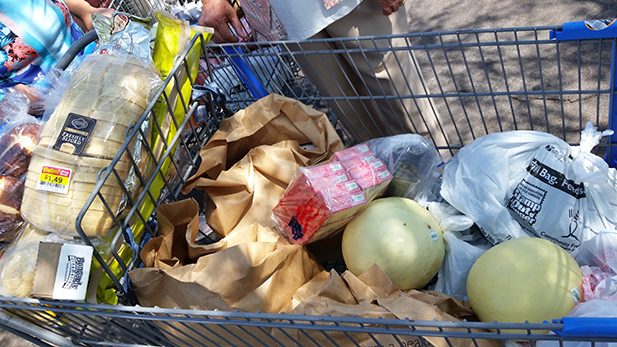 Clients at the Nogales Community Food Bank, across the street from Borderlands, pick up their monthly emergency food allotment, including some produce that was rescued from the landfill.
Clients at the Nogales Community Food Bank, across the street from Borderlands, pick up their monthly emergency food allotment, including some produce that was rescued from the landfill.He says the Community Food Bank severed ties with Borderlands before his time. He also says that isn’t the only bad blood he inherited. “It’s been fairly territorial. Everyone in the Wild West doing their own thing.”
Instead of coming in, as McDonald says, as an “800-pound gorilla” that takes over and tells everyone what to do, the Community Food Bank is trying to be a good partner and find ways to use the assets it’s accumulated over the past 40 years – like refrigeration and trucks – to help other agencies and organizations feed the hungry. As long as someone’s doing it, he says. It doesn’t have to the Community Food Bank.
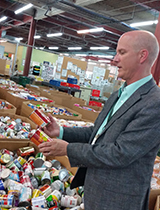 Michael McDonald, CEO of the Community Food Bank of Southern Arizona, in the main warehouse on Country Club and Ajo. The nonprofit feeds one in five people in Southern Arizona.
Michael McDonald, CEO of the Community Food Bank of Southern Arizona, in the main warehouse on Country Club and Ajo. The nonprofit feeds one in five people in Southern Arizona.But at the same time, the Community Food Bank is not getting produce from Borderlands. “We are working on other channels to get as much produce as we can on our own without having to pay for it,” McDonald says. The Community Food Bank and St. Mary’s Food Bank in Phoenix, received a grant to work together to expand their food rescue operation in Nogales.
“If I was in Yoli [Soto]’s shoes I would definitely say, ‘Yeah, they’re competing.’ I get it,” he says. “And that’s not good. That’s not ideal. People should shop at POWWOW. People should be proud to be part of a food rescue system that Yoli has put together through Borderlands to keep food out of the landfill and get it on their plates. That’s a huge thing.”
About the Community Food Bank revving up its produce rescue efforts instead of working with Borderlands, McDonald says: “The competition isn’t one another. The competition is time. That produce is going to waste.”
Food banks typically compete for scarce resources. Maybe there’s only one supermarket in a rural area and three agencies vie to get its food donations for their clients. But in this case, there’s more food on the border waiting to be rescued than either Borderlands or the Community Food Bank or St. Mary’s could ever handle.
Tune in to Arizona Spotlight or log on to AZPM.org next week for Feeding Our Future, Episode 8: Growing Community in the Barrios. Hear about home-grown efforts to improve Tucson’s struggling neighborhoods that started with vegetable gardens.

By submitting your comments, you hereby give AZPM the right to post your comments and potentially use them in any other form of media operated by this institution.